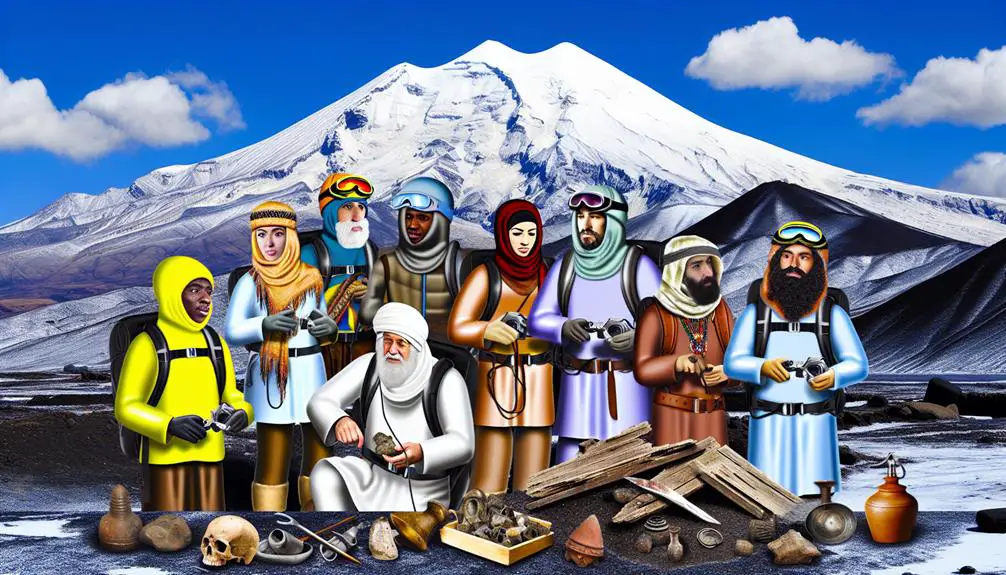Discover why Mt. Ararat's biblical connection to Noah's Ark intrigues scholars and believers, sparking endless debates and expeditions.

Mt Ararat in the Bible
You might not be aware that Mt. Ararat, while commonly linked with Noah's Ark, is not explicitly named in the original texts of the Bible as the Ark's resting place. This mountain's involvement is a result of centuries of tradition and interpretation, fascinating scholars and believers alike.
Its mention in Genesis as the resting place of the Ark after the Flood has sparked countless expeditions and debates. The historical and theological significance of Mt. Ararat extends beyond its biblical mention, influencing myths, legends, and cultural perceptions worldwide.
Let's explore the layers of mystery and faith that surround this iconic peak, revealing why it continues to capture the imagination of so many.
Key Takeaways
- Mt. Ararat is traditionally considered the resting place of Noah's Ark according to the Bible.
- The story of Noah's Ark highlights early civilizations' understanding of extreme weather events.
- Biblical and historical interpretations offer insights into ancient climatic events and their impacts.
- Geological and archaeological studies on Mt. Ararat explore the plausibility of biblical narratives.
Biblical Mention of Mt. Ararat

Mt. Ararat prominently emerges in the Bible as the resting place of Noah's Ark following the great flood. You'd find its significance woven into the narrative, marking a crucial geographical and symbolic point in the biblical text. Diving into Ararat's geography, you're looking at a mountain located in the eastern part of modern-day Turkey, near the border with Armenia. Its towering presence isn't just a landmark; it's a testament to the dramatic climatic conditions that can be found in this region.
These climatic conditions play a significant role in understanding why Mt. Ararat could be mentioned in such a pivotal biblical story. The mountain's elevation, reaching over 5,000 meters, subjects it to a range of weather patterns, from severe snowstorms to relatively mild summers. This variability could suggest why it was seen as a fitting backdrop for such a monumental event. Analyzing this, you get a sense of how geography and climate intertwine with biblical narratives, providing a realistic foundation to the stories that have been passed down through generations. The mention of Mt. Ararat thus serves not just as a geographical reference but as a bridge connecting the physical and the divine.
Noah's Ark and the Flood
You'll find that the story of Noah's Ark and the Flood, deeply rooted in biblical accounts, positions Mt. Ararat as the ark's final resting place, a detail that has fascinated scholars and believers alike.
The flood's global impact, as described, challenges our understanding of ancient events and their mark on human history.
Discussions on biblical evidence bring to light varied interpretations and the ongoing quest for archaeological verification.
Ark's Final Resting Place
According to biblical accounts, Noah's Ark found its final resting place on the mountains of Ararat after the great flood receded. The reference to Ararat has sparked considerable interest, leading to multiple geological studies and assessments of climatic conditions. These scientific endeavors aim to understand the environment during the time of the alleged event.
Aspect |
Details |
|---|---|
Geological Studies |
Focus on sediment layers and rock formations |
Climatic Conditions |
Analysis of ancient weather patterns |
Biblical Accounts |
Describe the Ark's landing on Ararat |
Scientific Interest |
High, due to the historical and religious implications |
This table provides a snapshot of the multifaceted approach to exploring the Ark's final resting place, integrating both scientific and biblical perspectives.
Flood's Global Impact
Beyond its biblical significance, the story of Noah's Ark and the Flood has implications for understanding ancient global climatic events and geological phenomena.
You're looking at a narrative that, beyond its spiritual teachings, offers insights into how early civilizations might've interpreted and recorded extreme weather events and their impacts on human societies.
It's not just about a deluge; it's about recognizing patterns of climate change and how they've historically led to geopolitical conflicts over resources, land, and survival.
These stories hint at humanity's long-standing struggle with nature's forces, suggesting that lessons from the past are crucial in addressing contemporary challenges.
As you delve deeper, you'll find that the Flood's narrative is more than a tale—it's a reflection on resilience, adaptation, and the complex relationship between human progress and environmental stewardship.
Biblical Evidence Discussed
While exploring the impact of ancient climatic events, it's crucial to examine the biblical evidence of Noah's Ark and the Flood for insights into these historical phenomena. The narrative, centered on Mt. Ararat, provides a compelling backdrop for understanding the interplay between geological formation and climatic effects.
Aspect |
Description |
Relevance |
|---|---|---|
Geological Formation |
Mt. Ararat's composition suggests activity |
Supports flood plausibility |
Climatic Effects |
Post-flood climate alteration evidence |
Indicates significant impact |
Historical Account |
Biblical description of the flood |
Offers context and scale |
Modern Interpretation |
Scientific analysis of the region |
Bridges ancient text and contemporary understanding |
This table highlights the critical elements connecting the biblical account with modern geological and climatic studies, offering you a nuanced understanding of Mt. Ararat's significance in both spiritual and scientific realms.
Historical and Theological Significance
You'll find that Mt Ararat's mention in the Bible isn't merely geographical but laden with deep historical and theological implications. It stands as a symbol of divine promise, a reminder of renewal and hope after destruction.
Furthermore, understanding Ararat's role in theology offers insights into the broader narrative of faith and divine intervention in human history.
Ararat's Biblical Mention
Mt. Ararat's mention in the Bible, specifically in the context of Noah's Ark coming to rest upon its slopes, holds profound historical and theological implications. This event isn't just a story; it bridges the divine with humanity, intertwining with Ararat's geology and the regional politics that have shaped the area for centuries.
- The geological features of Ararat spark curiosity and wonder, hinting at a past marked by monumental events.
- Regional politics add layers of complexity to Ararat, making its biblical mention not just a religious symbol but also a geopolitical marker.
- The narrative connects believers with a tangible point in history, grounding faith in the physical world.
- It invites exploration and scholarly debate, encouraging a deeper understanding of biblical events.
- Ararat serves as a silent witness to the passage of time, enduring through ages of human and divine history.
Symbol of Divine Promise
Ararat's role in the Bible extends beyond its geological prominence, embodying a symbol of divine promise that has significant historical and theological implications.
This mountain, where Noah's Ark reportedly rested, signifies more than a mere resting place; it's a monument to divine intervention and the fulfillment of promises.
The narrative surrounding Ararat and the Ark illustrates a pivotal moment of renewal and hope, underpinning the promise symbolism deeply ingrained in this story. It's not just about survival; it's about a covenant between the divine and humanity, a reassurance of protection and guidance.
This symbolism of promise, stemming from the Ararat narrative, has permeated various theological discussions, emphasizing the mountain's role as a tangible reminder of faith and divine commitment throughout history.
Theology and Ararat's Role
Exploring the historical and theological significance of Mt Ararat reveals its profound impact on religious narratives and beliefs. This geological formation isn't just a mountain; it's a symbol deeply entrenched in the fabric of faith, embodying renewal and divine promise. Its climatic influences have shaped the surrounding landscape, echoing the adaptability of faith over centuries.
- A Testament to Survival: Emphasizing resilience in the face of adversity.
- A Beacon of Hope: Inspiring generations to persevere.
- A Divine Landmark: Marking a sacred connection between heaven and earth.
- A Catalyst for Reflection: Encouraging deeper spiritual introspection.
- A Natural Wonder: Reminding us of the majesty and mystery of creation.
Through this lens, Ararat transcends its physicality, becoming a pivotal element in understanding faith's enduring essence.
Archaeological Expeditions
Numerous archaeological expeditions have aimed to unravel the mysteries surrounding Mt. Ararat, each hoping to shed light on its biblical significance and historical secrets. These endeavors often intertwine geological studies and climatic conditions analysis to construct a comprehensive understanding of the area's past. You'll find that researchers meticulously examine soil samples, rock formations, and fossilized remnants to piece together the mountain's geological timeline. They also scrutinize the climatic conditions, using them as a lens to interpret how shifts in weather patterns over millennia might've influenced human activity and natural events on Mt. Ararat.
The objective analysis transcends mere curiosity, aiming to authenticate historical narratives and biblical accounts tied to this iconic peak. Teams equipped with cutting-edge technology and traditional archaeological tools dissect layers of earth, hoping to find artifacts or structures that validate long-held theories about the mountain's role in ancient civilizations. Despite the challenging terrain and sometimes unpredictable weather, these expeditions press on, driven by the prospect of uncovering evidence that could illuminate parts of human history entwined with Mt. Ararat's imposing presence. Their findings, while sometimes inconclusive, contribute valuable insights into the complex tapestry of the region's past, offering glimpses into the lives of those who might've tread its slopes centuries ago.
Myths and Legends

Mt. Ararat, shrouded in a tapestry of myths and legends, has captivated the human imagination for centuries. This majestic mountain, standing tall at the crossroads of cultures, isn't just a geographical landmark but a storied monument steeped in Ararat folklore and mountain myths. You'll find that these tales, passed down through generations, offer more than just entertainment; they provide a window into the beliefs and values of the people who cherish them.
- Ararat folklore often speaks of a hidden realm within the mountain, believed to be a paradise inaccessible to mere mortals.
- Legends tell of an ancient, advanced civilization buried under ice and rock, waiting to be discovered.
- Many believe the mountain harbors the remains of Noah's Ark, a testament to human survival and divine intervention.
- Some myths recount the appearance of spectral lights on the mountain's slopes, thought to be the lost souls of climbers and explorers.
- Tales of guardian spirits watching over the mountain and its visitors play a significant role in local spirituality.
These narratives, rich in symbolism and mystique, underscore the mountain's significance beyond its physical presence. They weave a complex story of reverence, mystery, and exploration that continues to intrigue scholars and adventurers alike.
Cultural Impact and Perception
Beyond the realm of myths and legends, Mt. Ararat's influence extends deeply into the cultural fabric and perceptions of societies surrounding it. You'll find that Ararat artistry has become an emblematic theme, weaving through the tapestry of regional cultures. Artists, poets, and musicians have drawn inspiration from its majestic presence, embedding it into the core of their creative expressions. This mountain's silhouette doesn't just dominate the physical landscape but also looms large in the collective imagination, symbolizing both a historical touchstone and a beacon of spiritual significance.
Moreover, the mountain's portrayal in media and literature often reflects and shapes the identities of the people in its shadow. It's a symbol of endurance and permanence, qualities that resonate deeply in a region marked by the ebb and flow of time and history.
Regional geopolitics also play a significant role in the cultural perception of Mt. Ararat. It stands at a crossroads of nations, embodying a complex interplay of national pride, territorial claims, and historical grievances. This geopolitical significance adds layers to its cultural impact, making it not just a natural wonder but a pivot around which regional narratives and identities are constructed and contested.
Modern Explorations

In recent years, expeditions to Mt. Ararat have intensified, spurred by advancements in technology and a renewed interest in its historical and biblical significance. Explorers and archaeologists alike are drawn to this mythical peak, aiming to uncover secrets that have been buried under ice and time. However, their quests aren't without significant hurdles.
Climbing challenges on Mt. Ararat are formidable. The mountain's steep slopes and unpredictable weather patterns test even the most experienced climbers. Furthermore, geopolitical issues add another layer of complexity. The mountain's location at the crossroads of several countries means that navigating the legal and political landscape can be as tricky as the physical climb.
- The thrill of potentially uncovering historical artifacts buried beneath the ice.
- The sense of camaraderie among explorers, united by a common goal.
- The awe-inspiring beauty of the mountain's rugged landscape.
- The frustration and danger posed by sudden weather changes.
- The disappointment when geopolitical hurdles impede progress.
Despite these challenges, the allure of Mt. Ararat continues to attract modern explorers. Their perseverance in the face of adversity underscores the enduring fascination with this enigmatic peak.
Mt. Ararat's Global Fascination
While the challenges of exploration highlight the physical and political hurdles, the global fascination with Mt. Ararat stems from its deep-rooted place in history and myth. You're drawn to its enigmatic presence not just because of its biblical significance but also due to its imposing geology and the stories of those who've scaled its heights. The mountain's allure is as multifaceted as the layers of snow covering its summit.
Aspect |
Description |
Impact |
|---|---|---|
Ararat Geology |
Comprising two major volcanic cones, Greater Ararat and Lesser Ararat, its geological formation intrigues scientists. |
Offers insights into the region's volcanic activity and Earth's crust dynamics. |
Climbing Experiences |
Climbers recount challenging ascents, facing harsh weather and rugged terrain. |
These narratives add to Ararat's mystique, inspiring adventurers and researchers. |
Historical Significance |
Believed by many to be the resting place of Noah's Ark, it holds a pivotal place in biblical history. |
Fuels ongoing explorations and debates among historians, archaeologists, and theologians. |
Cultural Impact |
Symbol of national identity for Armenians and subject of countless myths. |
Deepens the emotional and cultural connection people have with the mountain. |
Analyzing Ararat's geology reveals its complex nature, while climbers' experiences underline the mountain's challenging and captivating essence. This synthesis of science, adventure, and lore continues to fuel global fascination with Mt. Ararat.
Frequently Asked Questions
How Has the Climate Around Mt. Ararat Changed Over the Centuries, and What Impact Might This Have Had on Preservation or Decay of Historical or Biblical Artifacts?
You're diving into how climate change around Mt. Ararat has influenced artifacts' preservation or decay. Climate models show shifting temperatures and precipitation patterns over centuries, impacting archaeological finds. These changes affect how materials decay or survive in the environment.
Are There Any Specific Environmental Conservation Efforts in Place to Protect the Unique Ecosystem Around Mt. Ararat, Given Its Biblical and Historical Significance?
Yes, specific environmental conservation efforts are in place around Mt. Ararat. These include reforestation projects aimed at restoring lost forests and wildlife protection measures to safeguard the area's unique species.
These efforts are crucial for maintaining the mountain's ecological balance and ensuring the survival of its biodiversity. They not only protect the environment but also preserve the area's significance by maintaining its natural and historical heritage.
How Do Local Communities Around Mt. Ararat Incorporate the Mountain Into Their Daily Lives and Cultural Practices Outside of Its Biblical and Historical Context?
You're exploring how locals around Mt. Ararat weave this monumental mountain into their everyday life and cultural festivities, setting aside its biblical fame.
From agricultural practices tailored to its slopes, enriching crops with unique flavors, to community festivals celebrating the seasons and the mountain's bounty, residents deeply integrate Mt. Ararat's presence into their cultural fabric.
This connection showcases a blend of tradition and adaptation, reflecting an enduring bond with the natural landmark.
What Role Does Mt. Ararat Play in Contemporary Geopolitical Tensions, Considering Its Location at the Intersection of Several National Borders?
You're looking at Mt. Ararat's role in contemporary geopolitical tensions, which is significant given its position at the crossroads of several national borders.
The mountain has become a focal point for Ararat diplomacy and border disputes, as countries vie for influence and territory in this strategically important region.
Its presence affects regional politics, serving as both a symbol of national identity and a point of contention among neighboring countries.
How Has the Depiction of Mt. Ararat in Art and Literature Evolved Over Time, Particularly in Works That Do Not Primarily Focus on Its Biblical or Historical Significance?
You've seen Mt. Ararat evolve in art and literature, transforming from a mere geographical landmark to a source of artistic inspiration.
Modern interpretations have diverged from its traditional imagery, showcasing its universal appeal and symbolic versatility.
It's fascinating how artists and writers have reimagined this mountain over time, often devoid of its biblical connotations, highlighting its aesthetic and metaphorical potential in reflecting human emotions, aspirations, and the sheer beauty of nature.
Conclusion
In conclusion, Mt. Ararat has long captivated the imagination, blending biblical narratives, archaeological pursuits, and cultural lore.
Consider the 1950s expedition led by Fernand Navarra, who claimed to have found a wooden beam on its slopes, sparking debates and fueling the mystery surrounding Noah's Ark.
This example underscores the mountain's enduring allure and its complex role at the intersection of faith, history, and exploration.
As such, Mt. Ararat remains a symbol of intrigue, inviting further inquiry and reflection.



Sign up